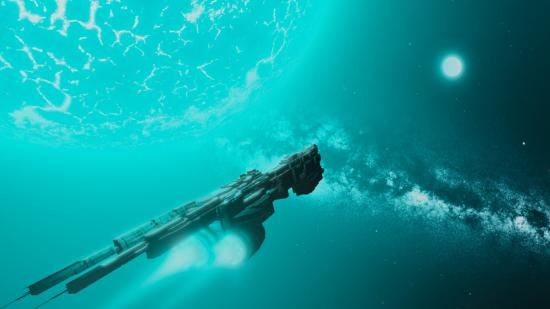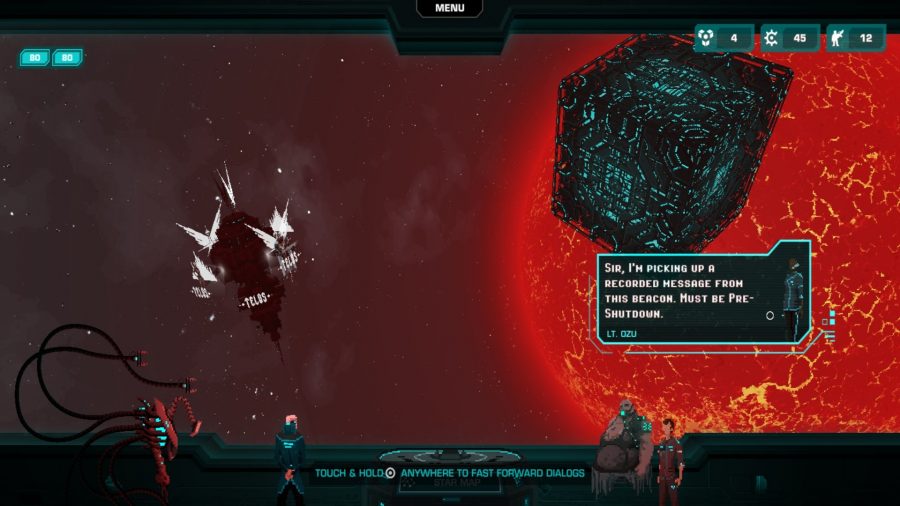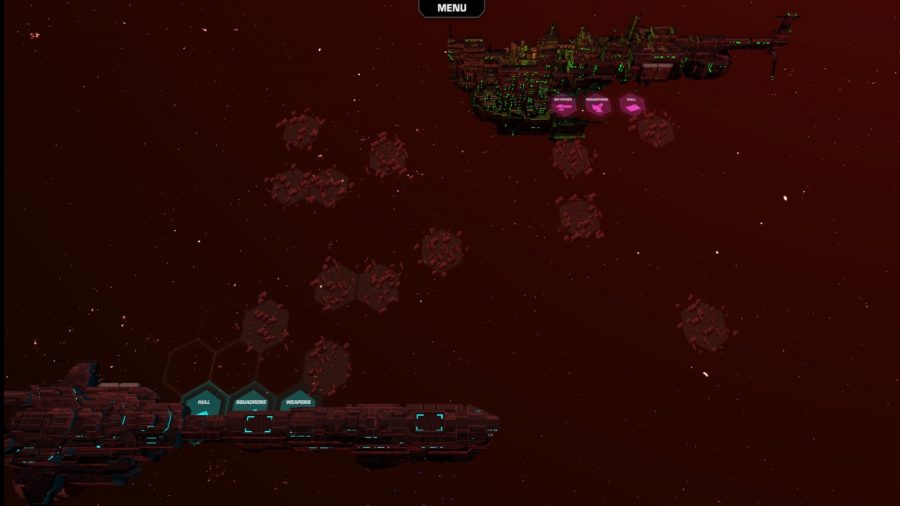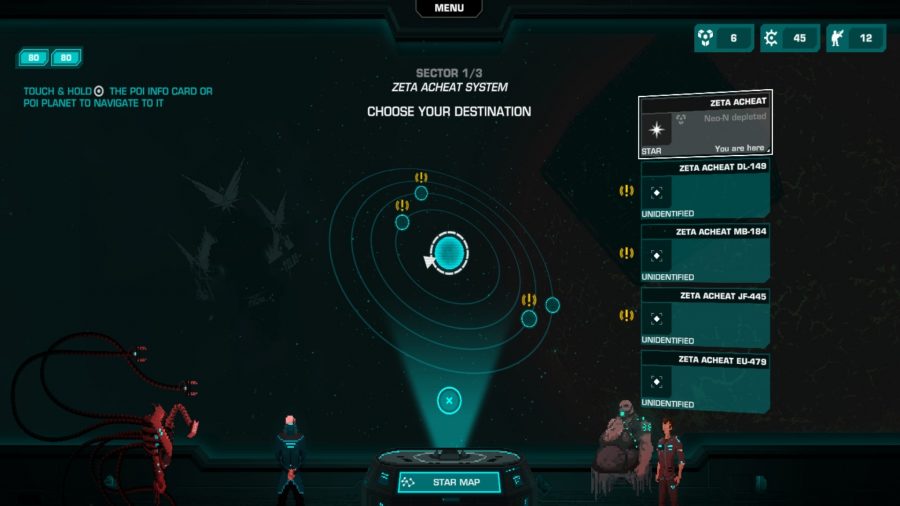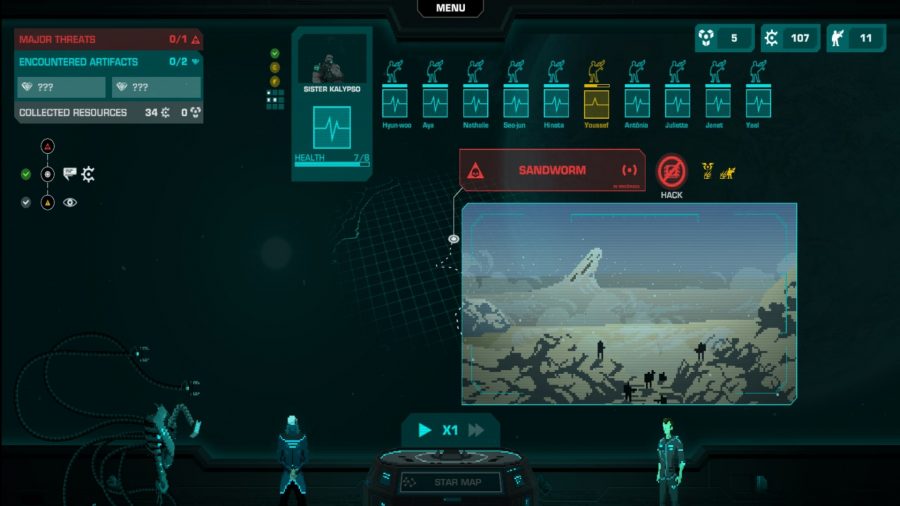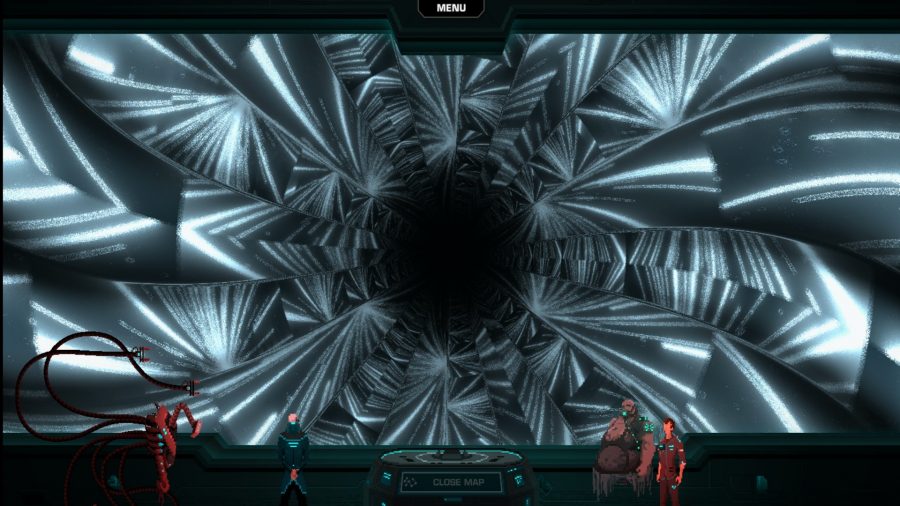Our Verdict
A sure pick for any who want an excellent resource management game or to live out their vicarious fantasies of starship captaincy
When I first started playing Crying Suns, I was struck by how many different things it is at once. You have elements of strategy from resource management games like Bad North, narrative events that you might find in an RPG, but then also rogue-like elements, a slick RTS ship battle system, and just a dash of Star Trek to top it all off. Crying Suns is a lot of things, but more than any other, it’s a starship captain simulator.
You begin your journey in a secret Imperial cloning facility, which feels very Matrix-esque, complete with a tentacled robot. This tentacled robot introduces himself as Kaliban, and apprises you of the fact that you are the clone of decorated Admiral Idaho, and he has awoken you because he has lost all contact with the Empire.
With Kaliban in tow, you choose two other clone officers, a ship, and set out on your journey into Imperial space. It quickly becomes obvious, however, that things have gone awry for the Empire, with radioactive scrappers – a little like Reavers from Firefly – ravaging the systems, and all advanced technology having shut down. You and your trusty crew must embark on a voyage to piece together this troubling turn of events.
This is where Crying Sun’s various influences start peeking their head’s out. The central objective of Crying Suns is to make it to the end of each sector, where you face off against a boss in the form of a ship battle, but the way you get there is entirely up to you. Resource management is the primary name of the game, as in each new system you can harvest a random amount of fuel – Neo-N – which is required to visit any destination within a system, or travel to the next.
But also, just like the game Bad North where its Viking horde consumes all in your wake, everytime you hop system in Crying Suns, the alert level goes up, and spreads to those systems behind you. If you run out of fuel, you’ll get caught, and have to fight a tough ship battle to survive – so it’s all a delicate balance. And that’s just one aspect of Crying Sun’s resource management.
There are also officers, squadrons, weapons, and commandos to consider, but the main way you interact with these elements is through the game’s currency: scrap. You gather this from events and encounters you pursue in each system, and is used to upgrade your ship, and buy, or repair any of the previously mentioned at a space station. You can also use it in narrative events.
That’s the long and the short of things – make your way through sectors of escalating difficulty, balancing the resource risk and reward of narrative and anomaly-based encounters, to gather enough strength to defeat each sector’s boss. It’s a clever formula, and one that reminds me a lot of risking soldiers or a second island per turn in Bad North, in the hopes of getting extra gold. My only criticism with that formula, is that when you lose upgraded combat resources in games of escalating difficulty, you lose big – often to the point that any return to form is impossible, and that run is effectively over. Crying Suns does have a clever way of somewhat mitigating this though, but first I’ll have to explain the game’s combat.
The actual strategic meat of Crying Suns is its RTS ship battles, where you face off broadside-to-broadside against an enemy dreadnought, across a hex-based grid. In these battles you have squadrons, belonging to four primary categories: drones, fighters, frigates, and let’s just call them big ships. Like the classic sword, spear, bow triangle of old, each of these types is more effective against another, except the anomalous big ships which basically do well at range and bad in close quarters.
During the course of each battle, you try to destroy the enemy squadrons, and then get your ships into striking distance of your enemy’s three hubs – weapons, squadrons, and hull. During all of this, you can also fire your equipped ship weapons on cooldown, either at enemy squadrons, or the ship itself. Now here’s the important element: weapons apply heat. If enough heat is applied to a section of the enemy ship, it can be disabled, temporarily preventing the enemy from launching more squadrons, or firing their weapons, and the same goes for you.
Also, when squadrons are destroyed, you can re-summon them after a short while in a ‘wrecked’ state, which means they have half-health. This is a clever method that means even if you lose combat resources in the game, it’s not permanent, and you can repair them to full fighting form at a station for scrap.
The other thing worth mentioning is terrain – the battlefield is dotted with asteroids and turrets, and some ship weapons, such as the Dark Matter Beam, can prevent enemies from crossing certain tiles, allowing you to chokepoint, or stack them up so you can hit them all at once.
Finally, there are the officers who have a hand in battles. You can have six officers overall, and each of their abilities grants a buff to the associated section you deploy them in. Some officers can increase ship speed, others absorb damage to the hull, and others speed up critical repairs when overheated, so where you deploy them is extremely important.
It’s a great system, where all of the elements have a knock-on effect on each other. I really appreciate the way that the game makes you feel like a star ship captain with squadrons, weapons, soldiers, and officers at your disposal. Most of the game takes place on the bridge of your ship, and it even parallels Star Trek, with the video transmissions from other ships that appear in front of you.
The commandos system is especially fun, where you can send soldiers on an expedition to a planet to recover resources. It’s a balance of attrition versus reward, very directly trading the lives of your soldiers for other resources, and the extent of that trade depends on which officer you put in command. As with most things in Crying Suns, it’s a case of risk vs. reward.
See? I told you it was impressive how many different influences Crying Suns draws from. Plus when you die in the game it’s back to the start, memories uploaded to another clone of Admiral Idaho, and the story continues. Crying Suns is a very full game, and the only thing I think it could really do with is a survival mode, through sectors of escalating difficulty. I don’t think the game’s narrative is especially incredible, and it’s narrative beats often feel a little more like info dumps, but that’s not unusual for a lot of strategy games.
Most of the time I was just captivated by the experience of being a ship captain, with all of these resources under my control, yet having to watch get slowly whittled away and sacrificed for progress. Maybe that’s what being a starship captain is actually like, eh?
